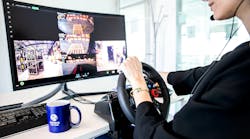Digitally Transforming Forklifts
Global logistics provider GEODIS recently partnered with Phantom Auto to develop a forklift truck that can be controlled from a distance. This innovative program is aimed at improving comfort and safety while also creating job opportunities for people with physical disabilities and others that are historically underrepresented in the logistics industry.
The first successful tests took place in France (Levallois and Le Mans) as part of a multi-year cooperation. The solution uses a Fenwick forklift combined with Phantom’s secure, network-agnostic, and interoperable remote operation software to enable remote workers to operate the vehicle, unlocking efficiency and equipment utilization gains. For example, one remote worker can operate multiple forklifts at a number of warehouses at different times of the day, all from one central location.
“Autonomy is an incredible technology, but it's not yet 100% ready for many of these deployments. As such, numerous edge cases exist where a human still needs to be involved,” Phantom Auto Chief Business Officer and Co-founder Elliot Katz says. “Even though manufacturers have applications for autonomous forklifts or AGVs, challenges exist within live operating environments where its other humans, other vehicles or stuff on the ground. A lot of these things can trip up the sensor suite.”
With remote operation software technology, digital drivers can remotely monitor multiple forklifts at once, and when intervention is needed, they can assist, either by giving a command, a human command to the forklift, drawing a path, or even remotely drive the forklift.
GEODIS remote operators, also referred to as digital drivers, will be able to "teleport" between different vehicles and between different warehouses with the click of a button, all from the safety of a distant office. Phantom’s software provides remote operators with real-time eyes and ears all around each vehicle, enabling them to safely and confidently guide the vehicles from wherever convenient.
“Phantom Auto’s technology enables dynamic balancing of workforce allocation, safer warehouses, enhanced worker well-being, and employment opportunities to those who otherwise could not physically drive forklifts,” says Stéphanie Hervé, GEODIS COO Western Europe, Middle East & Africa, in a statement. “This innovation will be of benefit to the wider community and indicates the future of logistics operations. We believe that technology should serve people, and that is what this partnership with Phantom Auto illustrates”.
Driving force
GEODIS has embraced the technology for multiple reasons -- the first being safety. After all, one in 10 forklifts are involved in in a serious accident each year causing loss of life or bodily injury. “As such, safety is an ever-present driver within warehousing spaces. By physically removing the forklift operator from the warehouse, a very significant safety gain exists,” says Katz.
With the pandemic there are health gains as well. “Warehouse environments were hit pretty hard by COVID-19, so reducing the number of humans physically inside the warehouse is a meaningful benefit,” says Katz.
Another driver is the ability to maximize productivity with digital driving centers in a central location. Consider the large company with warehouses or distribution centers all around the US. “With a centrally located digital driving center, when overflow exists in a New Jersey warehouse, you can instantly have five digital drivers to help address a surge. When things stabilize, those same drivers can become available to address overflow in another warehouse within a different region,” says Katz.
This means a company like GEODIS is no longer geographically constrained in terms of where it can hire forklift operators. The manufacturing industry is facing 2 million jobs that will go unfilled by 2025, with a highly striated workforce as currently 80% of forklift operators are men. Having a remote operation option also allows people with physical disabilities who would otherwise not be able to operate a traditional forklift to become digital drivers who can remotely operate forklifts. Simply put, it enables companies to expand and diversify the labor pool.
Making it work
Phantom provides a secure, low latency communication over volatile and constrained wireless networks, which enables reliable sensor streaming and safe control of vehicle functions. “Teleporting into any vehicle requires ultra-low latency and ultra-reliable wireless video and audio because we seamlessly and efficiently aggregate all available networks,” says Katz. “What we're doing is we're dynamically reacting to network volatility and consistently delivering high quality and ultra-low latency video, even in the most severely network constrained environments.”
Upon deployment Phantom does a very simple network mapping process, which can take as short as a few hours to a day. “And then as long as there's good network or robust Wi Fi network, we're off to the races,” he says. “Infrastructure changes or intense HD mapping are unnecessary because the Phantom technology is human centric. There is still a human controlling these vehicles – that human is just not physically sitting on the vehicle. This is not technology that is displacing humans from their jobs. It's augmenting human jobs and transitioning warehouse work into office work.”


